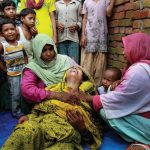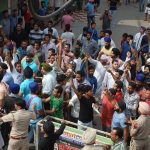Why Bijnor communal villainy did not spread

Heavy police deployment at Peda village in Bijnor after the communal tension (Photo credit – DNA – Manit)
By Saeed Naqvi,
I had the Muzaffarnagar riots of February 2013 at the back of my mind when I drove towards Pedda village on the Bijnor-Najibabad Road where three Muslims had been shot dead by Jats who fired with guns and pistols from the terraces of their homes.
Trouble began when two Muslim girls were harassed at the bus stop. When their men folk protested, the economically stronger Jats decided to teach them a lesson.
Muslims in Pedda have for generations been “dhobis” or washermen. In Sir Saiyyad Ahamd Khan’s framework, these are “arzals” or “menials”. Above them in the caste/class hierarchy are “Ajlafs”, weavers, and “Ashraf”, the genteel lot, the ones for whom the Aligarh Muslim University was initially opened.
That Yasmeen and Farheen are college-going girls is not a negligible detail: it is a glimmer of hope in a picture of unrelieved gloom which envelopes the community. Jats are prosperous farmers but socially static on issues like gender and are still bound by Khaps. The man-woman population ratio is eerily adversarial to women. In the Muslim hovel, there is economic want, not social regression.
Arrogance of economic power bristles at the sight of the lowest strata crawling upwards. This explains some of the accelerated violence against Dalits and Muslims. Caste and communal prejudice converge in such instances.
The gram pradhan or village head of Pedda, Anis Ahmad, is a short, dark man with a well trimmed beard and a mandatory skull cap, headgear which defines all Muslims from Madrasas. He has gone through the drill at the Deoband seminary, a stint as a tailor in Kuwait and now a dress designer (believe it or not) for “fashion shows”. He is not free of the usual Mullah hypocrisy: “I don’t touch female bodies; I tailor clothes for mannequins.”
With the advent of washing machines, Muslim washermen in villages like Pedda have diversified as tailors, barbers, fruit and vegetable sellers, automobile mechanics, handy men of all sorts.
The Pradhan takes me into the house where three men were shot dead on the terrace of their home. Below, in a dark verandah, women wail.
Outside, across the lane, is the fortified house of Pedda’s most powerful Jat, Sansar Singh. He hid in another village five kilometres away, but has since been arrested along with eight others involved in organising the violence.
A dozen or so policemen are snoozing outside Sansar Singh’s house, their weapons on their laps. This is the scene outside every Jat house in the lane up to the highway where a large number of policemen keep vigil.
“Look,” Anis Ahmad points his finger, “they are protecting only Jat houses.”
At Bijnor’s police headquarters, Superintendent of Police (Rural) Dharam Veer Singh thumps his table gently. “Yes, we are protecting Jat houses. If police were not posted as a deterrent, angry Muslims may retaliate against Jat women and children.”
Theoretically, Singh has a point but do Muslims in their current state of demoralisation ever retaliate? The two local journalists, Naresh Sharma of Swatantra Awaz and Jalil Ahmad of a local TV channel, India Voice, are crouching on Singh’s table, symbols of watchfulness.
Singh smiles: “Please give the police some credit for having prevented riots from spreading.”
Why did these riots not spread?
He cites geography as a roadblock to communalism. “The Ganga flows between Meerut, Muzaffarnagar and Bijnor — the communal wave that overwhelmed areas the other side of the Ganga some years ago weakens crossing the river.” There are other reasons for weakened communalism in Bijnor.
BJP President Amit Shah’s very determined presence in Muzaffarnagar and Shamli three years ago made the difference. Trumped-up stories of “love jihad”; fake video from Pakistan’s northwest circulated as Jats being lynched by Muslims; Maha Panchayats of weapon-wielding mobs and Amit Shah’s famous refrain, “Yeh badley ka election hai” (We go into this election to seek revenge) — all augmented the incendiary atmosphere. Today, there is saffron in the air, true, but not murderous saffronisation.
In Bijnor, Muslims as well as the administration (even some Jats) have praised the local MLA, Ruchi Veera of the Samajwadi party, who was present in the village round-the-clock for the duration of tension. In fact, she was able to extract Rs 20 lakh from the government in Lucknow by way of relief within days of the violence. Assessments of damage are being made for more.
District Magistrate Jagat Raj is flanked by City Superintendent of Police M.M. Baig and Senior Superintendent of Police Umesh Kumar Srivastava to address about 60 print and TV journalists around a giant oblong table. Seldom have I heard media being so lavishly thanked for having exercised restraint.
On my return, when I cross the barrage on the Ganga, I remember SP Dharam Veer Singh’s words: rivers block communal waves. Before reaching Meerut, I see road signs to Muzaffarangar. I have horrible memories of that pogrom. Past Meerut is Maliana, the site of the notorious 1987 massacre. The police had separated 42 Muslim young men, lined them up by the nearby canal and shot them.
P. Chidambaram was Rajiv Gandhi’s Minister of State for Home. He knows that incident like the back of his hand. He is now a columnist. May be some day he will give us the inside story on why the case drags on into its 29th year? Approaching Ghaziabad, I see signs to Dadri where in September 2015 Mohammad Akhlaq was lynched by cow protection vigilantes. His family is still implicated in unproved charges.
As lights of Delhi shimmer, the villainy of Pedda recedes. Nastier memories surface.
(A senior commentator on political and diplomatic affairs, Saeed Naqvi can be reached on saeednaqvi@hotmail.com. The views expressed are personal.)—IANS



No comments:
Post a Comment